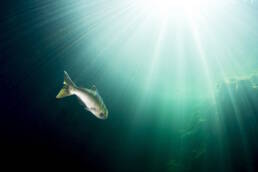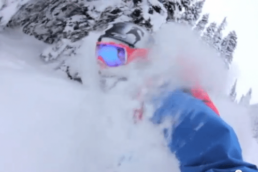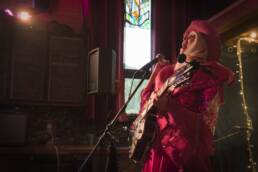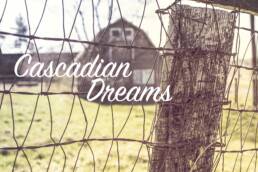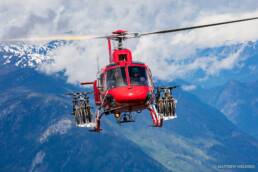Up and down Cascadia’s coastline, vital creeks and wetlands are being diverted or destroyed by urban sprawl, federal bureaucracy, and Earth’s warming ways. But hundreds of stalwart volunteers are digging in and raking muck for the precious salmon and its precarious future. By Jeff Davies.
Ian Bruce has the calloused hands and ruddy complexion of someone who spends a lot of time out in the elements. He looks down and studies a thin brown ribbon of water. “The gravel here looks pretty good,” he says, “but it’s sharp, and it will wear out the tails as the spawning female salmon try to dig their gravel beds and lay their eggs.” We’re standing on the banks of Swan Creek in suburban Saanich on Vancouver Island, British Columbia, under a bridge with the steady thrum of traffic overhead. There’s graffiti all over the abutments. “We’ve got taggers,” says Bruce. “You will find not only have the walls been tagged but they will throw their paint cans in [the creek] to add insult to injury.”
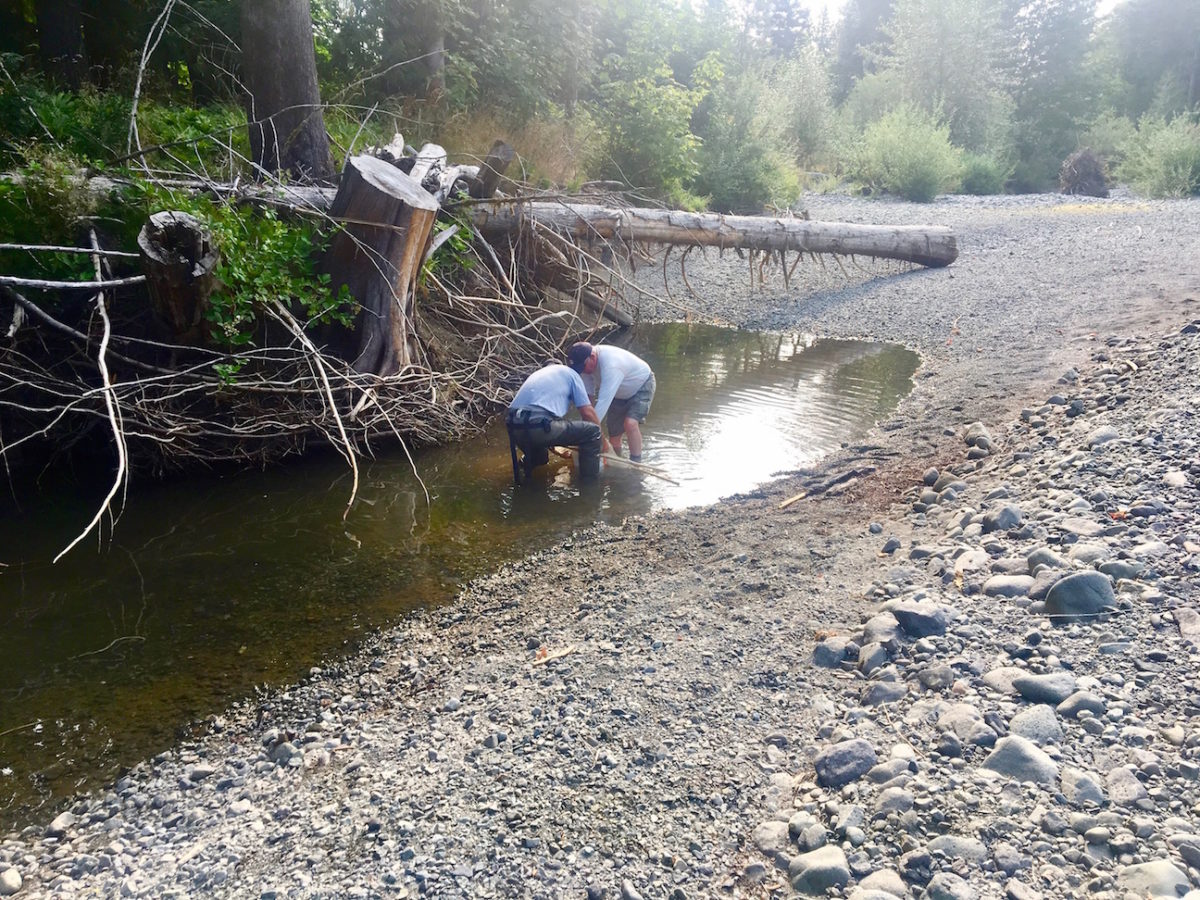
It’s hard to believe this is a salmon stream, but coho salmon will spawn in creeks you can spit across. This is Bruce’s workshop, so to speak. He is a fisheries biologist and the executive director of the Peninsula Streams Society. He’s one of only four paid staff, but he monitors the work of hundreds of volunteers who help to restore and sustain salmon habitat in more than a dozen streams in the Saanich Peninsula. On this sultry August evening, Bruce is working with another biologist and a crew that includes members of the Friends of Swan Creek Watershed. They’re beginning a new project, clearing brush and building spawning beds. Big piles of river rock have been deposited in several locations along the bank. “We put about 60 tonnes in Swan Creek in the last four or five years by hand and could probably put in 100 times that and still not be done,” Bruce says. Rehabilitating a stream starts with the city helping to scoop out the rough gravel, Bruce explains, then volunteers replace it with smooth river rock, hauling wheelbarrows full of rocks to create “a line of round rocks between the size of a grapefruit and the size of a basketball, which will support spawning gravel. … It will hold back gravel and oxygenate the water and cool it and provide many functions for the stream environment.” Bruce says having volunteers do the heavy lifting saves taxpayers’ dollars and ensures the community is engaged in maintaining salmon habitat. Indeed, without volunteers, the coho in these streams may not even exist.
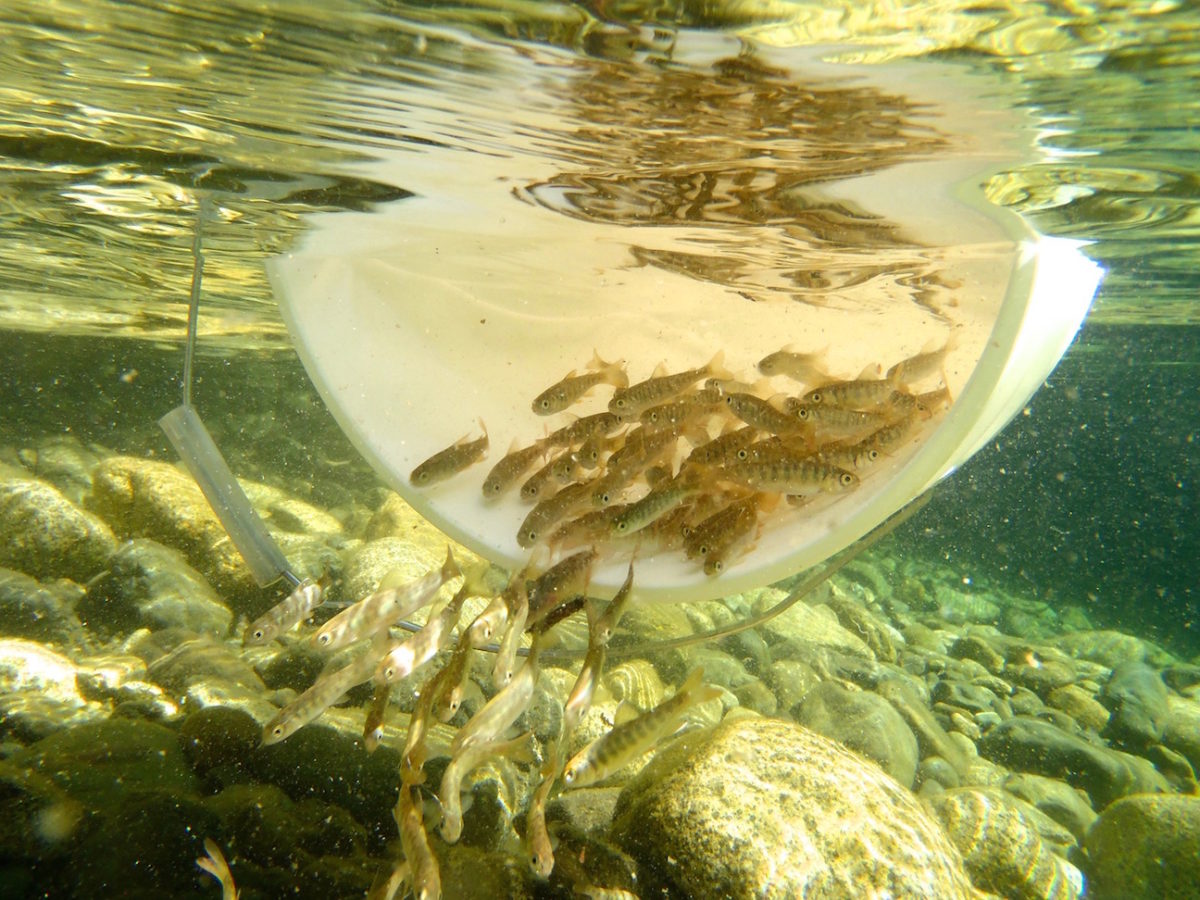
IF SALMON ARE THE LIFEBLOOD of the oceans, then volunteers are the lifeblood of British Columbian streams. From stream walkers who count fish and report to the viciously underfunded Fisheries and Oceans Canada (DFO) to those who haul gravel, people not getting paid to promote healthy salmon is the norm. You’d think they would be bitter, but the truth is, they revel in it. “[I feel] pretty good,” says Art Crouse, who lives less than a block away from the Swan Creek project. “It’s dirty, wet, hard work, but it’s worth it to be able to see the salmon dig their little furrows and lay their eggs six or eight feet away from you, it’s pretty great.”

Crouse got his start building little waterfalls in Swan Creek just for fun. Then one day he found one of the conservationists taking measurements in the stream. They struck up a conversation, and he was hooked. What began as a hobby has become a passion. “We are so lucky to have the salmon—period,” says Crouse. “The fact the salmon can do what they do and go out to sea for three years and find their way back to this little part of this stream miles from the ocean and lay eggs and die and then the cycle continues, it’s pretty great.”
A neighbour, Brian Herring, watches from the far bank. He grew up here in the 1960s. “They used to call it Copley’s Creek,” he says. “It was crystal clear, then they built all that Northridge subdivision, and I watched the water and all the fish leave. I used to catch trout, stickleback, sunfish. Gone before my eyes. It broke my heart when I saw what happened.” There was, says Bruce, simply no thought given to the impact on salmon and their spawning habitat as the wetlands were drained and subdivisions built.
It’s a familiar story, and one that’s played out in many streams on the British Columbia coast. Coho are particularly vulnerable since many spawn in small creeks that can easily be damaged by diversion or pollution. The young coho also spend as much as one to two years in freshwater before heading to the sea, so they’re vulnerable when those streams start to warm and dry up in summer. But when those little streams are literally in suburban backyards, they’re highly visible. That makes it easier to motivate communities to get involved in restoration. Just ask Peter McCully at the Goldstream Volunteer Salmonid Enhancement Association near Victoria, “Were it not for the efforts of these volunteers, the coho in the Goldstream would have been extirpated years ago.” He concedes some may argue against this kind of intervention, but the volunteers are helping to restore salmon runs damaged by development, agriculture, logging, and mining.
McCully is paid a consulting fee by the Goldstream hatchery and serves as technical advisor there, but much of his work is voluntary. “The structure itself was built by volunteers and it is operated by volunteers.” McCully describes the group as eclectic, with a retired geologist, engineers, journeymen carpenters, electricians, and plumbers. When he started volunteering here in the 1970s, there were fewer than 50 coho returning to spawn in the fall. “We refer to that as demographic extinction. In simple terms there were so few that they couldn’t find a date.”
The hatchery gets help from the Capital Regional District, technical advice from the DFO, and grants from the Pacific Salmon Foundation (PSF), a non-profit charitable organization established three decades ago to help preserve salmon stocks. Since its inception, the PSF has funded more than 2,000 projects and engaged more than 35,000 volunteers. It has an annual budget of $9 million, with more than 70 per cent going to grants and awards. The president and chief executive officer of PSF, Dr. Brian Riddell, says the volunteers are invaluable. “For every dollar the salmon foundation gives them in cash, they return a total value of about seven to one, so it’s really an example of the incredible power of communities.”
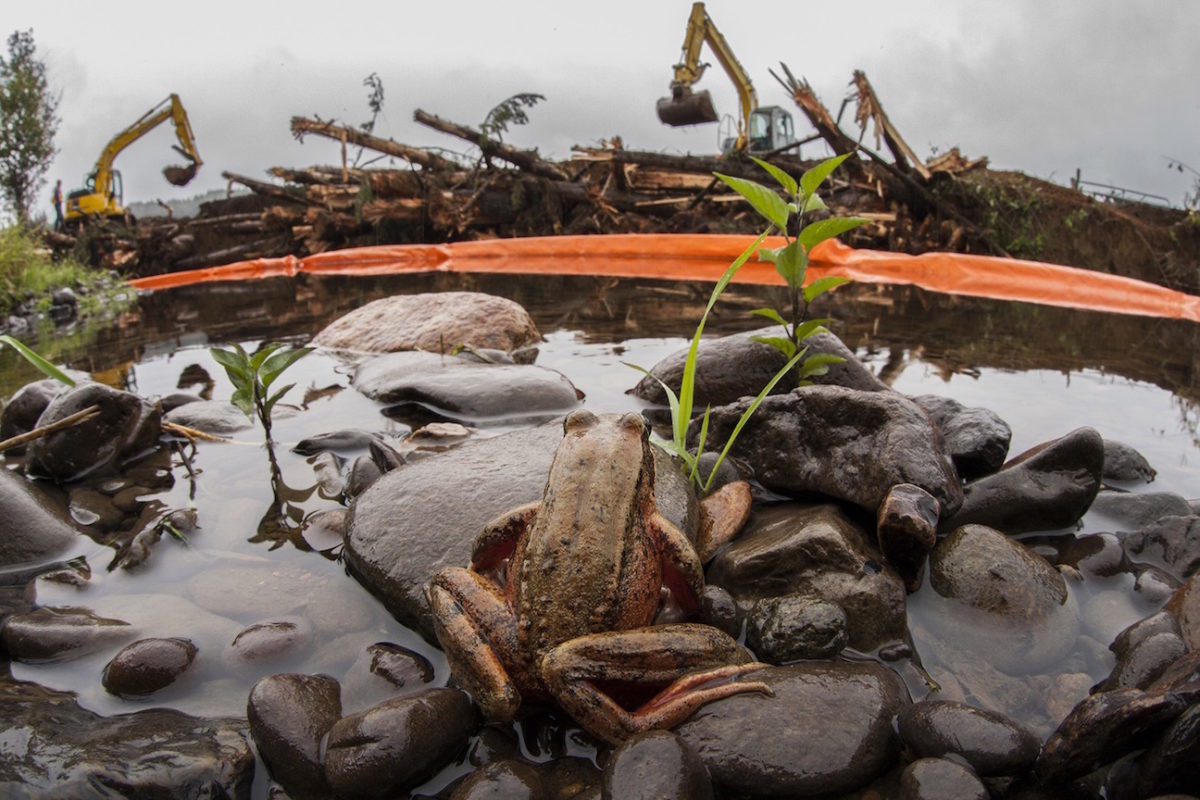
At Goldstream, the volunteers’ tasks include stripping spawn from salmon and fertilizing eggs. On many smaller streams, volunteers have taken on the job of stock assessment, walking the streams in the fall to count the returning salmon. Some visit classrooms to get schoolchildren involved. McCully says it raises awareness and helps to educate the public about the importance of protecting salmon habitat. He and the others were stunned when the DFO stopped funding the education program in 2017. There was a public outcry and the department backed down almost immediately. McCully says the federal bureaucrats are “Ottawa-centric,” and the DFO doesn’t have the money to do hands-on work in small streams. So volunteers have taken on the job through initiatives like this one on the south island. “This program is a no-brainer in that it has value and that it achieves wonderful things.”
Ottawa, meanwhile, seems far away on a hot summer day in the Cowichan Valley, where Parker Jefferson and Sandy Cumming are on a coho rescue mission. They park their vehicles on a side road by a bridge, pull on their waders, and head down a sandbar on the Robertson River. The term “river” almost seems like a cruel joke this summer. The Robertson has been reduced to a few linked pools amid gravel and baked mud. But there are underground springs keeping those pools cool, about 12ºC, and the young salmon fry are alive, albeit stranded with no way to reach the mainstream. Jefferson and Cumming are armed with nets and buckets. This summer their group has scooped up 33,000 coho fry and transported them to Cowichan Lake where they will grow into smolts before descending the Cowichan River to the sea. The community as a whole, including local First Nations, has rescued about 100,000 fry.
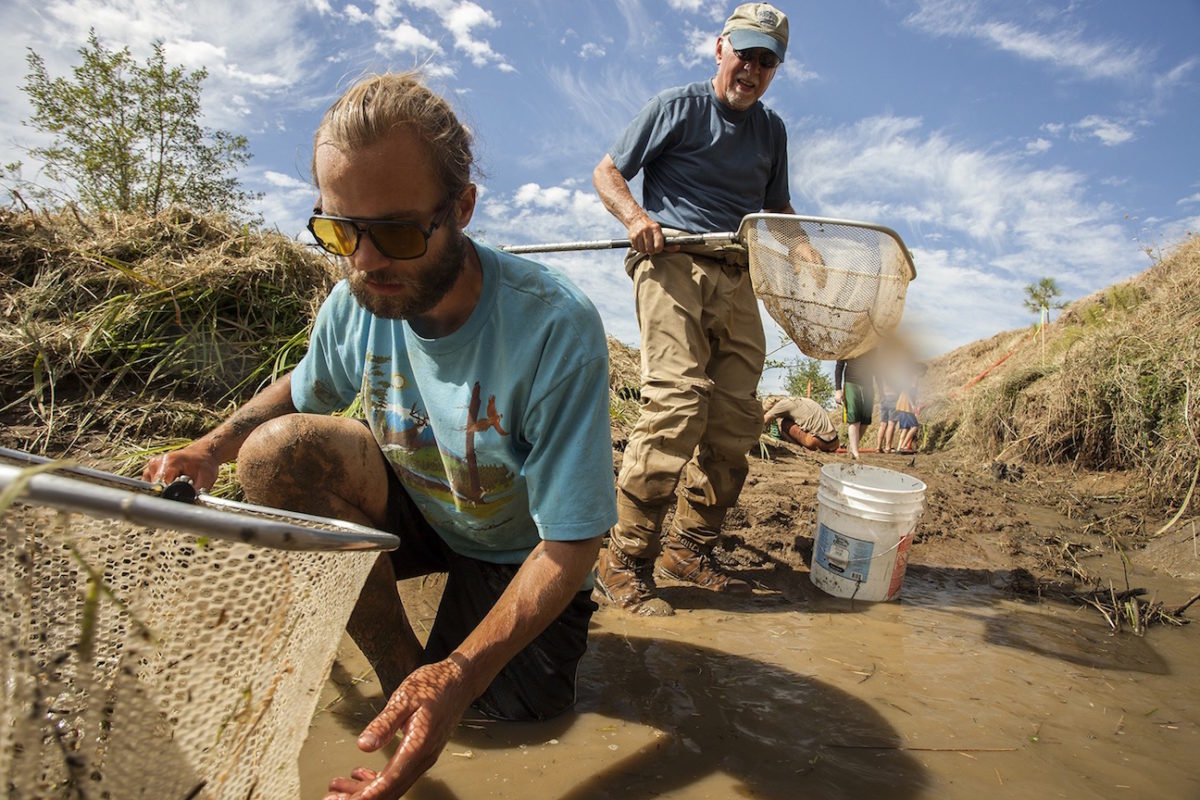
Jefferson, a retired advertising producer and keen angler, says about two to three per cent of these will return as strong wild fish. “If you enhance your wild populations, nature has shown it’s better to preserve wild fish. But when you add up to 100,000 that is a significant return.” He and Cumming, who is retired from the military, say they’re also doing this for future generations. “The [Cowichan Lake] Salmonid Enhancement Society is really involved with the local schools,” Jefferson says, “showing kids the lifecycles, having given them little fry they can rear. We have school tours every year where they take the grade fives and sixes and sevens and show them all about this, and we tell them we are doing this for you and we hope some of you will take this work on. … They love it. They really get into it.”
Jefferson calls salmon the canaries in the coal mine, “If they go the whole ecosystem will start to collapse.” Adam Olsen agrees. The rookie MLA for the BC Green Party is a member of the Tsartlip First Nation on the Saanich Peninsula. “Each and every one of these little streams is of course incredibly important to the whole picture,” he says. “These are literally the veins … the circulatory network of our communities. And I have stood in the legislature almost daily and talked about salmon and all of the work that has been founded upon the central core principle that good salmon policy is good environmental policy, good economic policy, and good social policy.”
Coho are particularly vulnerable since many spawn in small creeks that can easily be damaged by diversion or pollution. The young coho also spend as much as one to two years in freshwater before heading to the sea, so they’re vulnerable when those streams start to warm and dry up in summer.
Olsen remembers hearing his elders’ stories of how many salmon there were in the old days. “My grandfather, my dad’s dad, used to tell the story that the salmon used to be so thick in Saanich Inlet that you could walk across on their backs to visit our relatives on the Malahat. These are fantastic fishing stories, right? These are stories that capture the imagination but also speak to a time when salmon runs were remarkable.” That was also a time when the communities were founded at the mouths of streams. “Every town, every village, every city is built on the life-giving capacity of the creek or river or stream,” he says.
These days, the communities around Saanich Inlet are no longer fishing villages, and many of the little streams have few, if any, salmon. Olsen speaks of a sense of sadness among First Nations. “There is a disconnect between my relatives here and the creeks and streams.” His children, now 11 and six, have never fished in Saanich Inlet, as Olsen did growing up.
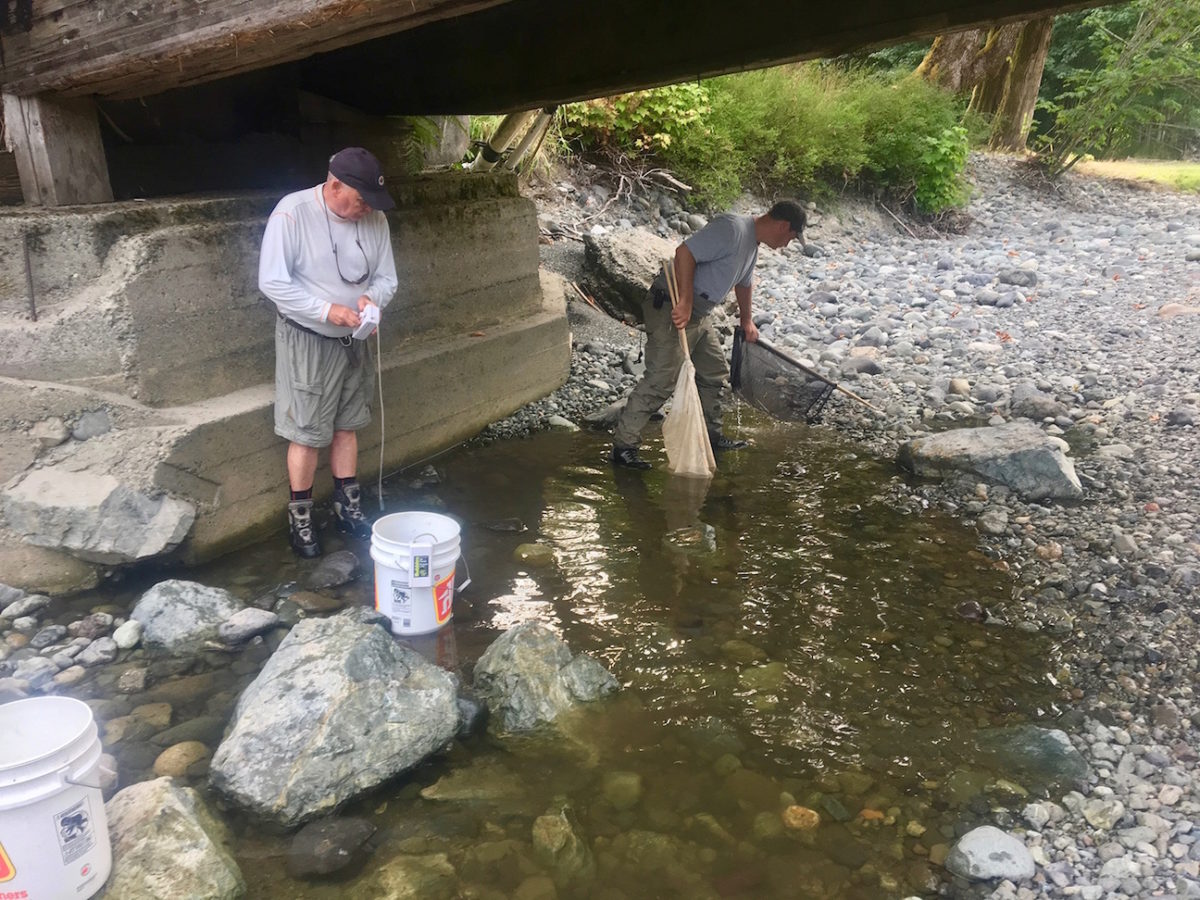
And yet there are those little success stories. Consider Reay Creek, which runs past the Victoria International Airport into the Strait of Georgia near Sidney. It is so small it could easily be mistaken for nothing more than storm sewer. Indeed a sign on the culvert where the creek passes under the road labels it as a storm drain. “It was a shopping cart-sized creek—with shopping carts in it,” says Grant MacPherson, vice president of the Sidney Anglers Association. “All the adjoining lands around there ran into the creek.” Just imagine what runoff may flow from the airport. “It’s had fish completely killed in it seven times.” But about 40 years ago, the anglers’ group led an effort to have the flow replenished with water from a town well. The DFO built a small dam upstream to ensure there was enough water to sustain fish, and the community came together to clear out the creek and restore the habitat. It is a work in progress, but it seems to be paying off. “When we started to do volunteer stream walk counts in winter we had a lot of anecdotal evidence. … Between 20 and 40, in a good year, adult salmon will come back,” MacPherson says.
It all counts. Talk to the biologists and they’ll tell you the stocks from those little streams are distinct, and each one contributes to the survival of the species. “They are the diversity for coho salmon,” says Dr. Riddell. “They are incredibly well-adapted to small streams.” Of course, while the coho themselves may be resilient and tenacious, preserving the stocks also demands a degree of political will. No one knows that better than David Anderson, former Victoria MP and former federal fisheries minister. “You do need to manage for the fish, not the fishermen,” Anderson says. Back in the 1990s, he introduced tough new regulations meant to preserve wild coho. Furious fishing-lodge owners protested, saying they’d be forced out of business. Anderson was unmoved. “Zero mortality was my slogan. You couldn’t achieve that, but you could reduce it dramatically, and we did.”
Back on tiny Swan Creek, meanwhile, the volunteers have finished their work and are waiting for the coho to make their way to the restored spawning beds. By mid-November the signs are not good. Only about 100 salmon have been tallied at the counting fence downstream on Colquitz Creek. A few fish died without spawning. Bruce isn’t sure if it’s because of low water, warm temperatures, or agricultural runoff. But the work of the volunteers will continue, “You can build it and hope they come.”
Jeff Davies is a freelance writer and retired CBC political reporter living in Victoria, British Columbia. His home is near the confluence of Colquitz Creek and Swan Creek, where he can watch amorous salmon procreating and dedicated volunteers preserving salmon habitat.
Jeff Davies
Jeff Davies is a freelance writer and retired CBC political report based in Victoria, British Columbia. He left the legislative press gallery in 2012 to spend more time enjoying the great outdoors and writing about it.
Related Stories
Livin’ Tiny: A Quest for Powder
Livin' Tiny: A Quest for Powder Where would you go if your house were portable? Would you spend each night in a new…
Tiny Lights – The Best Little Festival That Did
The town of Ymir (pronounced "Why-Mer") has always been small. It's been around for 120 years but the current…
Should Cascadia Leave North America?
Cascadia. It's not Canada. It's not America. It's ... better? Given the current political climate of soon-to-be "Trump…
Skyride Upside – How a New Rack is Changing Heli-biking
Two years ago we wrote about how one Revelstoke company had invented a long-line rack for heli-biking. Now,…
Why Tiny Invasive Mussels Are a Huge Deal in BC
This past summer, while driving around British Columbia on vacation, you likely spotted the bright orange signs set up…


